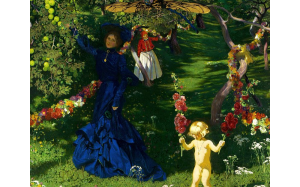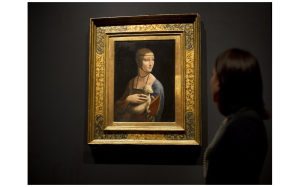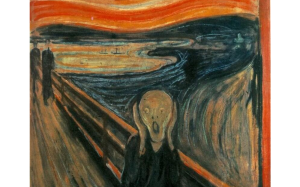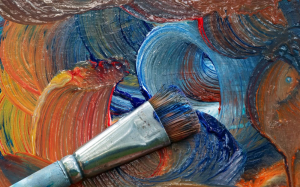Jazefa Mehofffer’s “Wonderful Garden”
 The picture is filled with the sun, full of bright colors of the summer, with joy and carelessness, it’s hard to tear your eyes: the longer you look, the more you want to be next to the characters among the lush greenery and flowers, and even more so – to hide under the shade of trees and watch a giant grandmother.
The picture is filled with the sun, full of bright colors of the summer, with joy and carelessness, it’s hard to tear your eyes: the longer you look, the more you want to be next to the characters among the lush greenery and flowers, and even more so – to hide under the shade of trees and watch a giant grandmother.
“Dzywny ogród” by Jozef Mehofffer undoubtedly extends beyond the portrait of the artist’s closest figures – it’s unrivaled and one of the most important paintings of Polish modernism, which today attracts and enchants its artistic beauty. The painting was created during the summer holiday of the artist and his family in Siedlcu, a city in Poland, in 1902 (finally completed in 1903, as evidenced by the inscription).
The canvas presents three persons: the wife and son of the artist and baby nanny. The openness of the scene to the viewer is coupled with the intimate character of the painting, because only the relatives could so pitilessly pose for the artist, and he, in turn, seems to open the veil of his personal, happy life (joyful child, beloved and lover’s wife). The axis of the composition is determined by the diagonal created by the artist with the help of a path that disappears in the depths of the garden. The numbers appear to spring from the avenue, shaded with apple-crowns, and follow toward the viewer’s open sun lawn.
Our gaze attracts the figure of a naked boy who gently steps on the soft grass and holds his long arms in the raised pink-red mall. The boy seemed to swim in the sun and radiates and reflects sunlight, which causes admiration for childish beauty and innocence. For the little ones, there is a mother dressed in an elegant sapphire dress and hat. The woman is presented on the side of the garden and partly hidden in the shade, only the bottom edge of her dress is lighted by the sun. She is looking upward towards the viewer, and perhaps her husband, with an elevated and easily inclined head; the left hand holds the dress, and the right stretches in the direction of the branches of apple trees, densely covered with fruit. In the depths of the shady alley there is a figure of a nanny – a girl dressed in a people’s Krakow line and lit by single rays of the sun falling through the crown of trees.
Juzef Mehoffer, Strange Garden (Dziwny ogród), fragment. National Museum in Warsaw.
The picture is dominated by the atmosphere of the summer: juicy herbs of trees and grasses, colorful flowers, bright sun, branches leaning under the burden of ripe fruit. A characteristic feature of the canvas is the limitation of the viewer’s horizons: he looks from above, from a small distance to the depths of the garden, without covering the sight of his boundaries. The spectator’s eye is directed from the main figures to the depths of the alley by means of garlands of flowers and trunks of trees that are removed.
But the garden is amazing not only with its bright colors. An element that violates the harmony and peace of the picture, while at the same time causing some surprise, magic, maybe even trouble, is a giant lady overlaid on the canvas. It is written entirely naturalistic, but on the background of the garden it seems completely foreign, such that does not fit into the landscape and figures walking in the garden, which, in fact, they do not notice. Perhaps it is a kind of reflection of the artist’s presence? Its presence can also be explained by the appearance of an insect in front of Mehoffer’s eyes, which looks at his wife and son while working on the picture. The grandmother can also be perceived as an element that demonstrates the conventionality of the image as it is completely flat and thus not within the picture, as if it contradicts the principles of its design. The grandmother is beautiful, but at the same time he is atrocious to a certain extent, no doubt that it creates a mysterious aura of the Divine garden, an important feature of this canvas, and its beauty is also mysterious.
However, the strength of this picture lies, first of all, in the fact that, regardless of knowledge on the subject of the author and the circumstances of the creation of this work, the viewer sees in it the true beauty that intrigues and provokes suggestion of some elusive meanings.





